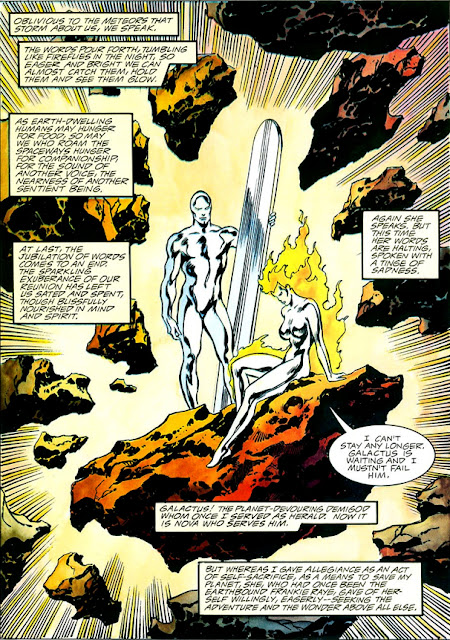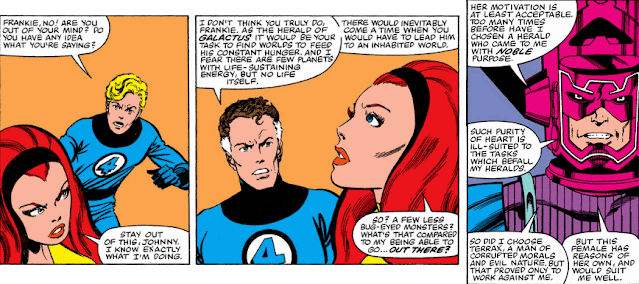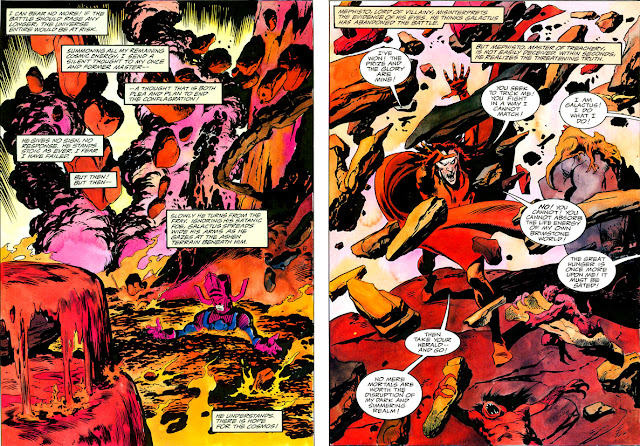One project from Marvel which completely slipped under my radar in 1988 was the Silver Surfer: Judgment Day graphic novel--plotted by artist John Buscema and Marvel Editor-In-Chief Tom DeFalco, scripted by Stan Lee, and clocking in at sixty-two pages. The story's climax features a confrontation between the Surfer's perpetual menace, the demon Mephisto, and his former master, Galactus--with Nova, the current herald of the planet devourer, playing the role of unwitting accomplice caught up in Mephisto's web of deceit.
In addition, as will become quickly evident, Buscema has decided to contribute full-page art for the entire story--perhaps a complication as far as tying together the visuals in a meaningful way while awaiting sufficient captions and dialog to hopefully provide a riveting and engrossing experience for the reader. This work would be years removed from the books of the Silver Age where Lee hit his peak in doing just that, for the most part--but while Lee would prove to be more than adequate in handling the Surfer's 1978 graphic novel delineated by Jack Kirby, a story where a writer had the luxury of dealing with more conventional panels which offered the opportunity for details and subtleties that would do a great deal to invest the reader in the story, here there is instead mostly grandiosity to account for, along with Mephisto's trademark guile and relentlessness which tend to transfer easily from story to story without much variation. Given the format which Buscema has settled on, is Lee up to what's being asked of him?
This excerpt from the story's Foreword almost gives the matter a sense of mitigation after the fact, though that may be reading too much into it:
All of that being said, it was an interesting venture for Buscema and Lee to undertake, and, I don't doubt, a successful one. John Byrne took his own steps with such a format two years earlier with a 22-page story for Marvel Fanfare--the difference of course being that it played out on a third of the scale, but also having the advantage of the artist and writer being on the same page, as it were, in terms of a tighter meshing of story and art (at least to the extent that such a format would allow). The same could be said for Walt Simonson's similar effort in a story published toward the end of his run on Mighty Thor just a few months later. Here, the bar is raised a bit for Lee, who fared well with his collaboration with Kirby as well as his one-shot story with Byrne (the latter also having involved Mephisto) but must now go beyond DeFalco's and Buscema's outline to craft a compelling and engaging tale, with virtually each page holding a measure of responsibility for its success.
The story begins with another failed attempt by Mephisto to entrap the Surfer and thus seize his soul. And as the demon ponders his latest setback, it's clear that his resolve to achieve his goal is as steadfast as ever.
"Again the deadly plan of Mephisto has been put to rout! But what does it matter?" A refrain that has become as worn as a doormat by now where the Surfer is concerned.
From there, the Surfer catches a respite with the arrival of Nova, the scene nicely handled by Lee and offering some insight which gives us a sense of the passage of time for two beings who call the stars their home and whose travels take them beyond their furthest reaches--as well as how rare and welcome contact with a fellow wanderer might come to them.
The encounter is also a glimpse into the contrast between the life the Surfer once led and the mantle which Nova has now assumed as the herald whose task it is to search for a suitable world which will sate the hunger of Galactus with its life force. How interesting to see the Surfer take a back seat when it comes time to make a decision on whether to select such a world which lies in their path, delegating that choice solely to the one who will bear the responsibility for that choice.
Clearly Nova has come a long way from the woman who stepped forward on the fateful day that Galactus again came to Earth and offered herself as his new herald--the consequences to other life forms in the universe be damned.
Yet perhaps the past isn't as buried for Nova as both Galactus and ourselves had believed, when we see Nova fall into the same trap the Surfer had avoided and become corrupted by the words of Mephisto (though not by name)--and in so doing, picking up a thread which Byrne introduced five years earlier which had her questioning whether she was falling in love with Galactus. From that point on, Nova has no scruples about leading him to worlds teeming with life, as eager as she has now become to win his approbation and, hopefully, more.
Consequently, the being whose approach had in the past caused entire races to either flee their worlds or perish to the last man in resistance begins to once more decimate whatever planet is in his herald's line of sight.
It's a spectacular series of images by Buscema which Lee scripts with all due grimness and fatality. And as information comes his way on the series of disasters which mark the coming of Galactus, the Surfer sets out to stop Nova from helping her master to commit more atrocities--and in so doing, effectively thwarts the intentions of Galactus, though he and Nova both pay the price.
As hopeless as things now look as far as either the marooned Surfer or Nova being able to further interfere with Galactus, for Mephisto the way is paved to take advantage of that helplessness and strike his long-desired bargain with the Surfer--achieving a goal that has eluded him, even as Nova at last understands her part in this drama.
Unbeknownst to Mephisto, Nova quickly acts to do what she can to help both herself and the Surfer, though our next sight is inevitably that of Mephisto's domain, where it seems the demon is in no hurry to fulfill his promise to the pair--particularly when there was "fine print" in his offer that made no mention of when that promise would be satisfied. But Nova's earlier effort to signal her master succeeds--assuring that two wielders of great power meet to decide just who will fall prostrate before the other, even as the Surfer forms a plan that might bring an end to the conflict.
During this story, Lee has fairly consistently handled the ways and workings of Galactus which have demonstrated the same level of detachment, the same unexplainable, indeterminate manner, that the character has maintained in previous appearances. As farewells go, then, we can expect to find nothing less--or, as the Surfer notes, nothing more--in the offing, which Lee seems to realize is quite fitting for the nevertheless optimistic note that the Surfer strikes on his departure, bringing an end as well to this impressive piece of work from both artist and writer.
Sigh. Until next time, pal.






















Great post, C.F., and an interesting comic. I haven't seen this one. It's a novel use of an old comic cliche, or trope--put two badasses in a room together and let 'em duke it out. Then watch the furniture get moved around.
ReplyDeleteOf course, these things tend to be inconclusive.
I get that Galactus is basically an anthropomorphic embodiment of cosmic destruction (somebody's gotta be that, apparently) but the character of Mephisto always bothered me. A little over-the-top for my tastes.
Not one of Stan's better villains, I would say. Not a lotta subtlety there.
Almost vaudevillian.
M.P.
Thanks, M.P., and I did indeed find it interesting--though I was particularly intrigued by Buscema being given credit as co-plotter, something I frankly don't recall happening often if ever.
ReplyDeleteI don't recall seeing that credit before either, but surely the 'Marvel method' in the 60s meant Buscema would effectively have been co-plotter on the original Surfer series?
ReplyDeleteI appreciated this look at a book that passed me by too Comicsfan, but I'm afraid I can't agree with you at all that Stan Lee 'hit his peak' on the first Silver Surfer series. For me it was quite weak compared to, say, the Thor and FF of the second half of the 60s, because while Buscema was a phenomenal artist he just wasn't a creative force in the same way as Kirby (or Ditko) which is what Lee really needed to work off.
And from what I see here, this book looks very much like an update of the early double-size era of the Surfer comic: great artwork - its always nice to see Big John doing his own inks - but... not much else.
Sorry, but I just find the "philosophical" scripting and dialogue Lee bought to the Surfer really bland. I mean, c'mon -
"In the swirling enormity of space, time can so easily be forgot.
When surrounded by infinity, what need is there to measure hours?"
Was that kind of thing really Lee's idea of elevating comics to a higher level, and being taken seriously?
-sean
sean, while I'm certainly with you on Lee's tenure on the first Silver Surfer series (though assigning Buscema as the reason for Lee writing the Surfer so despondently frankly never occurred to me), I was speaking more broadly in regard to Lee hitting his peak in Marvel's Silver Age books, where he seemed fully vested in his characters and his style of writing made for an engaging and exciting story. (I still consider Fantastic Four and Amazing Spider-Man to be his crowning achievements in that respect.)
ReplyDeleteThe "Marvel method" also crossed my mind when writing that response, but I think there's a difference between being given the bare-bones plot by a writer and being told to run with it (after which the writer would adapt his dialog accordingly to what the artist came up with) vs. sitting down with either a writer or editor and having actual input to what's going on with the characters, how they should react to/in a situation, and how the story should progress. After Lee stepped back from writing, we began to see a number of co-plotter credits listed between writer and artist, which I dare say improved the reading experience for a number of Bronze Age stories. (Say, that's not a bad idea for a future post. :))
That does sound like an interesting idea for a post, Comicsfan. Possibly as well as tracking the 'Marvel method' with the reading experience it might also be worth considering the 'writer/editor' credit that became more common in the second half of the 70s...?
ReplyDeleteBtw, I read somewhere (I know, I know, everyone's read something somewhere about Marvel in the 60s, but bear with me) I read that the later Lee/Kirby comics - a quick flick through an Essential FF suggests from around the start of '67 - were credited without specification as just 'by Stan Lee and Jack Kirby' supposedly as an acknowledgement of Jack's contribution to keep him on side ie while he didn't get the (co-)writing credit he maybe felt he deserved, he didn't NOT get it either.
I just bring this up in relation to Buscema's work on the original Silver Surfer series, as looking at the first few issues the splash pages just say (with a bit of added Marvel-style hyperbole) 'by Stan Lee and John Buscema'...
-sean
A good observation about Lee's and Buscema's "collaboration" on the Surfer's first series, sean. As for the Marvel method, I'm more or less content with having said my piece on the subject in an earlier post.
ReplyDelete